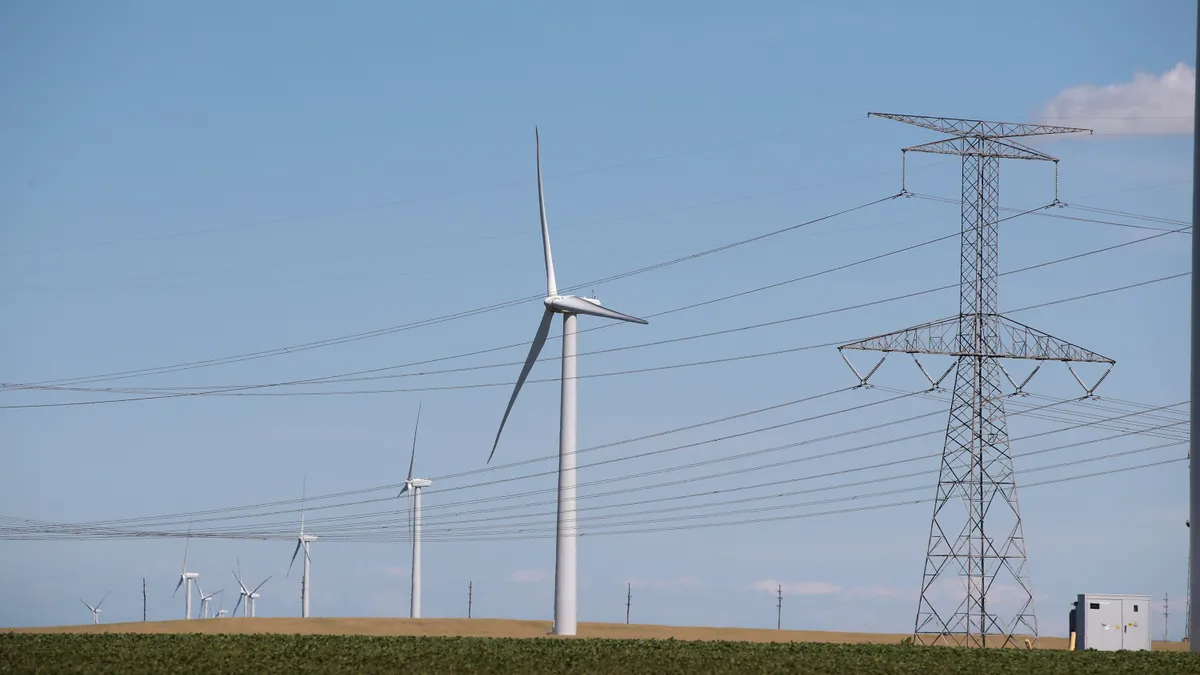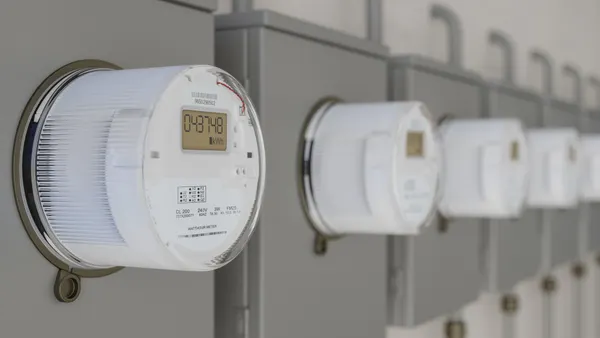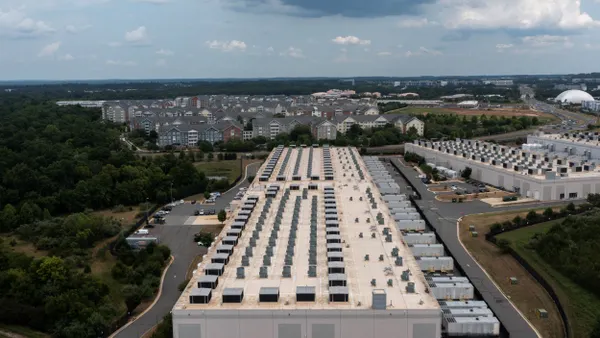Transportation, building and industrial electrification are needed to reduce power system emissions, but are also a threat to system reliability, according to a report from one of the biggest U.S. grid operators.
The use of clean energy-generated electricity by those sectors will significantly increase and change system load and peaks, the Midcontinent Independent System Operator's (MISO) Electrification Insights, published in April, reported. The level and pace of change remain uncertain, but cost and reliability effects are almost certain to be significant, which makes understanding the impacts critical, the Insights said.
"It can be very hard to quantify risks from electrification and they're likely far in the future, but we wanted to capture what we know and detail the unknowns," MISO Policy Studies Engineer and Insights lead author Hilary Brown told Utility Dive. "This first major effort shows there will be changes in demand and in seasonal and daily peaks, but we cannot not yet identify when and where the impacts will be."
With MISO's shift to renewables, electrification will drive an "unprecedented" transition and MISO and its stakeholders need to understand "potential reliability risks" and work "toward solutions," the Insights reported.
"MISO has a wide variety of stakeholders" and "there is little certainty" about where or how much it will impact the system but it is "already happening faster in some places than MISO planned for," Clean Grid Alliance Executive Director Beth Soholt said. Because of the uncertainty, "least-regrets planning will be needed, and this report seems to be a start."
An admirable first effort, but with confusing uncertainty and a glaring omission of energy storage and the importance of least regrets strategies is what many state regulators, utilities and power system analysts told Utility Dive they took away from MISO's first insights on the coming transformation to electrification.
Midcontinent electrification emerging
MISO's April Insights report studied the potential impacts on its system from electrification in the transportation, building and industrial sectors through 2040, Brown said. It focused on the four guiding principles of MISO's Reliability Imperative mission statement by addressing markets, transmission planning, operations and systems development.
Many of the issues surrounding the changes that will come with electrification were addressed in MISO's Renewable Integration Impact Assessment (RIIA) Report from February, its MISO Futures paper from April, and by the MISO DER Task Force, formed in January. Like MISO's Electrification Insights paper, they considered a range of projections for renewables growth. Though the RIIA report assumes a 30% renewables penetration, the Electrification report sought more certainty by using only 20% renewables.
The Electrification Insights' reference scenario assumes no electrification and load growth producing a 0.56% compound average growth rate (CAGR) for energy demand in the MISO region through 2040. Its low, moderate, and high scenarios have increasing levels of electrification with energy demand CAGRs through 2040 of only 1.44% to 2.89%.
Customer adoption driven by lower costs and decarbonization policies will increase electrification in residential and industrial space and water heating, cooling, and new appliances and equipment, MISO's Electrification Insights reported. There has already been exponential growth in light-duty electric vehicles and record growth in medium and heavy duty EVs in 2019 and 2020.
This "electrification has the potential to transform MISO system-wide demand from the traditional summer peak to a winter peak," the Electrification Insights reported.
"New loss-of-load risks appear" as higher morning and evening daily demand peaks and sharper ramps are forecast to replace MISO's current summer afternoon peak "over nearly all months," due to "uncontrolled" EV charging and heating and cooling loads. Significant generation and transmission investment will be needed to manage the changes, it added.
MISO's assumption for all three increased electrification scenarios in the report is that these load growth projections do not include responsive, flexible, or controllable load capabilities exacerbate planning uncertainties, many stakeholders said.
MISO and its stakeholders should consider strategies to manage the higher peaks and sharper ramps from electrification, the Electrification Insights said, though without data-based specifics. Flexible technologies driving electrification like EVs and electric space and water heaters also "have the potential to offset extreme [energy demand] ramps," and if they are not used, conventional generating units will be needed, it warned.
Changes in system planning will require ensuring resources are available to meet all periods of system stress, the paper said. That will require operational changes to monitor the increasing occurrence of peaks and ramps with increased electrification, and changes to market incentives to drive adequate procurement of flexible, responsive, or controllable loads or generation to manage system risks.
A graph created for a presentation of the paper's findings to MISO stakeholders "shows what was determined by the research and what remains uncertain about the impacts of electrification," MISO's Brown said.
Unknowns and uncertainty
The upper left quadrant of the graph shows the knowns.
At higher levels of electrification, "we start to see daily morning and evening peaks, and with more renewables, the ramps to those peaks will be steeper," Brown said. "Those changes are likely and will offer operational challenges."
The upper right quadrant is "the known likelihood and unknown impacts" of changes due to electrification, she said. "Moving the seasonal peak will have an impact, but we don't know what the qualitative difference will be between summer and winter peaks."
"The biggest unknown unknowns are the pace of change, the controllability of the changes, and the need for system flexibility."

Jordan Bakke
Director of policy studies, MISO
The bottom left quadrant represents the uncertainty of when and how controllable the known increasing peaks and ramps will be, Brown said. It remains to be seen "how flexible our system can be."
And the lower right quadrant question marks are "unknown unknowns" about renewables growth and the emergence of technologies that change other assumptions about what will be needed to manage increased electrification, she added.
The trend toward electrification is clear, added MISO Director of Policy Studies and Insights co-author Jordan Bakke. "The biggest unknown unknowns are the pace of change, the controllability of the changes, and the need for system flexibility."
Consumer adoption rates electrification technologies and regional differences are also uncertain, said David Sapper, director of market intelligence — MISO markets, for energy management consultant Customized Energy Solutions. "Electric heating depends on the price of natural gas and the viability of hydrogen and heat pump adoption."
New market and interconnection rules and policies for distributed energy resources (DER), including storage, and renewables price declines could drive rapid electrification, he said. The Electrification Insights study is "a small victory" but "threshold" state regulatory decisions on utility control of DER could "open the flood gates" for electrification and change assumptions about system needs to manage it.
Utilities, regulators and other stakeholders largely agreed about the uncertainties of what electrification is coming and what MISO will need to address it.
Uncertainty in "the rate and magnitude of electrification" will be produced by "market trends, customer behaviors, technologies, and cost," Entergy Energy Vice President for Enterprise Planning Elizabeth Adams said.
Electrification is emerging, but "no one knows precisely what the increase will be, or the exact the pace of the transition," agreed former Federal Energy Regulatory Commissioner Tony Clark. "Major breakthroughs are always a wild card" though planners tend to prefer proven technologies even for "new challenges" like the growth of electrification.
The paper's projections for MISO region electrification reflect "political and economic reality in the MISO footprint," but transitions to electric home heating and transportation electrification include "significant uncertainty," agreed former Illinois Commerce Commission (ICC) Chair Brien Sheahan.
Electrification of heating is "not financially or politically practicable" because of the MISO region's cold winters and costs that would be stranded in the natural gas system, he said. And the transportation transition "faces considerable uncertainty in terms of scale, timing and policy support."
MISO is doing "the technical work to understand the need for energy sufficiency over 8,760 hours of the year and not just peak periods," Clean Grid Alliance's Soholt said. But it "is bogged down in the enormous complexity of the many moving pieces and the decision-making process." Still, MISO members "cannot wait for absolute certainty or they will not be ready to charge cars and heat buildings."
One area of MISO planning fell falls especially short on understanding the impacts and needs from increased electrification, utilities, regulators and other stakeholders agreed. MISO needs to do a lot more work on storage.
The omission of storage
The absence of energy storage in MISO's Electrification Insights "doesn't make sense," said InterTran Energy Consulting Founder and Principal Dr. Rhonda Peters, who monitors MISO proceedings. "Electrification will be a game changer, but storage is also a game changer, and if you're not looking at these two simultaneously, you're only looking at half the equation" to protect reliability, she added.
The Electrification Insights study addresses "reliability and resource adequacy needs from electrification, but storage changes those needs," Peters said. MISO is not considering how storage changes calculations about generation, ancillary services, demand response and DER, and reduces the need for natural gas peakers, she added.
Storage is an important factor but there is too much uncertainty around its future costs, technologies, and system integration rules to include it at present, Electrification Insights report lead author Brown said. MISO declined Utility Dive's request for further input.
But regional planning assumptions for system growth seem to require significant storage, Customized Energy Solutions' Sapper agreed. Utility plans for storage expansion just in Wisconsin and Iowa over the next five years exceed MISO's assumptions through 2040, he said.
MISO planning seems to be for less storage than utilities are planning, member utilities told Utility Dive. The Michigan Public Service Commission found MISO planning for storage "far too low," Chair Dan Scripps said.
But planning storage needs for MISO is more difficult than in other places because short-duration storage has less value where winter reliability events "can last multiple days," Great River Energy Manager for Member Services and End Use Strategy Jeff Haase said. Battery storage is not now a cost-effective long-duration alternative in MISO regions, agreed former ICC Chair Sheahan.
After the RIIA assessment was published, stakeholders requested more consideration of storage "and got the same answer as this report provides," said Clean Grid Alliance's Soholt. "We were told 'we don't know what the market rules are going to be.'" But modeling for Xcel Minnesota has shown that storage plus renewables can be a cost-effective alternative to new natural gas plants, she added.
"Utilities want to invest in storage because they can see it is going to play a significant role in the Midwest in electrification and the transition to renewables," Soholt said. But until market and interconnection rules for storage make that possible, there are least-regrets strategies for addressing increased electrification that MISO has overlooked, she and other stakeholders said.
MISO's overlooked least-regrets solutions
Grid Enhancing Technologies (GETs) represent a least-regrets solution for manging rising and changing load from increased electrification because they can be quickly deployed to increase existing wires capacity and meet reliability needs at a fraction of the cost of new wires, Smart Wires General Manager, Americas, Mark Freyman said. And they can be redeployed when reliability challenges emerge elsewhere.
There are four types of GETs, said Grid Strategies Vice President Jay Caspary. Power Flow Control relieves congestion by rerouting electricity flows. Dynamic Line Rating (DLR) allows system operators to use more of the line's capacity, topology optimization automatically reconfigures system flows, and storage is an alternative to transmission. MISO's omission of these technologies is a "deficiency," he said.
GETs, like storage, are important technologies, but they were not included in MISO's study because it did not consider mitigation strategies, report lead author Brown responded. MISO declined further comment.
"Electrification will require expanding transmission and, until recently, the hundred-year-old model for expansion was building or upgrading lines," said Hudson Gilmer, Co-Founder and CEO of DLR provider LineVision. GETs "represent a new model for expanding capacity."
"Ramps and peaks are going to change with electrification," said Smart Wires' Freyman. GETs "meet the near-term need by allowing access to underutilized capacity on the system, and when that need is resolved, the hardware can be redeployed to address challenges from new transportation or building electrification load at another location."
"Utilities are rightfully conservative about protecting reliability, but electrification is part of a historic shift that will require new approaches."

Jonathan Marmillo
Co-founder, LineVision
The ultimate solution for electrification's risingh and changing loads, peaks, and ramps is new transmission, but it takes time to get transmission projects approved, permitted, sited, financed and built, Caspary said. GETs are readily deployable to allow dispatchers to limit the severity of ramps and the extent of peaks by using more line capacity.
The MISO 2020 State of the Market Report from market monitor Potomac Economics issued in May concluded the changes provided by GETs "will substantially improve the utilization of MISO's transmission network and ultimately lower the costs to MISO's customers," LineVision Co-founder and VP of Products Jonathan Marmillo pointed out. And FERC is working to support wider deployment.
"Utilities are rightfully conservative about protecting reliability, but electrification is part of a historic shift that will require new approaches," Marmillo added. "GETs are a least-regrets strategy to address uncertainties as they formulate larger planning and will eventually be a part of system planning."













